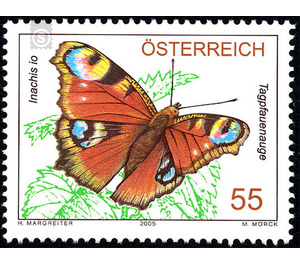butterfly - Austria / II. Republic of Austria 2005 - 55 Euro Cent
Theme: Animals
| Country | Austria / II. Republic of Austria |
| Issue Date | 2005 |
| Face Value | 55.00 |
| Edition Issued | 1,000,000 |
| Printing Type | combination printing |
| Stamp Type | Commemorative |
| Item Type | Stamp |
| Chronological Issue Number | 1880 |
| Chronological Chapter | OOS-OE2 |
| SID | 492018 |
| In 48 Wishlists | |
This new series is dedicated to the Austrian wildlife. This first brand of this series features a butterfly that is not only found in the wild, but also in the gardens, the popular peacock butterfly. Inachis io belongs to the family of the noblefolk (Nymphalidae) and is with its intensive coloring and drawing one of the most beautiful butterflies in our latitudes. The moth is common in Asia and throughout Europe, with the exception of Scandinavia. The wingspan of the red to red-brown wings reaches 5-6 cm, they show the typical large, usually black and blue colored stain, which mimics the appearance of an eye to deter enemies. The underside of the butterfly is dark, so the butterfly is almost unnoticeable on a dark background. The butterfly female lays about 200 eggs, especially the undersides of stinging nettle leaves are particularly popular. After about a week, the caterpillars, who are still sociable at the beginning, hatch and build a spider's nest. The grown caterpillars then move freely on the plant and eat mainly nettle, currant, blackberry, hops, etc. They are velvety black with silver-white dots and thorny bristles. After the 4th skin, they pupate and after two weeks the adult butterflies hatch. In warm climates this process is repeated a second time in late summer. The peacock butterfly hibernates in cavities such as tree hollows, trusses, old houses and barns. The moth begins to fly every year when the weather gets milder again, and delights nature lovers as one of the first harbingers of the warm season. Like all butterfly species, this is unfortunately at risk. Not only by natural enemies and strong climatic fluctuations during the winter, but also by poisonous sprays, intensive soil management and unfavorable weather conditions their habitat is getting smaller and smaller. In the butterfly paradise of Langschlag, not only the peacock butterfly eyes but also many other butterfly species have a safe and natural refuge. This dreamlike butterfly and nature paradise is located in the Waldviertel in a huge park and offers with its millions of flowers the optimal habitat.


